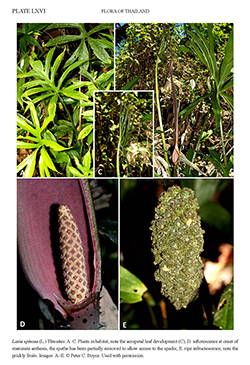e-Flora of Thailand
Volume 11 > Part 2 > Year 2012 > Page 249 > Araceae > Lasia
Lasia spinosa (L.) Thwaites
Enum. Pl. Zeyl.: 336. 1864; Engl. in A.DC. & C.DC., Monogr. Phan. 2: 273–274. 1879; in Engl., Pflanzenr. IV, 23C (Heft 48): 24–25, fig. 9. 1911; Gagnep. in Lecomte, Fl. Indo-Chine 6: 1107–1109, fig. 105,1–2. 1942; Hu, Dansk Bot. Ark. 23: 416–418, Pl.II. 1968; Hay, Blumea 33: 458–462, fig. 15 & 16; Li & Boyce in H.Li. et al., Fl. China 23: 16. 2010.— Dracontium spinosum L., Sp. Pl.: 967. 1753.— Pothos spinosus (L.) Buch.-Ham. ex Wall., Numer. List: 4447 C. 1831. Plate LXVI.
Accepted Name : This is currently accepted.
Synonyms & Citations :
Description : Robust, colony-forming, stoloniferous, evergreen helophytes to 1.5 m. Stem thick, prickly, rarely unarmed, erect to decumbent, epigeal or submersed, green. Leaves several together; petiole to 100 cm long, aculeate, weakly pulvinate apically, sheath relatively short; leaf blade (juvenile) sagittate to hastate-sagittate, (adult) deeply pinnatifid in anterior division, with posterior divisions pedatifid, sometimes simple, 18–75 by 6–35 cm; major veins aculeate on lower surface; primary lateral veins pinnate in anterior division, pedate in posterior divisions; higher order venation reticulate. Inflorescence solitary; peduncle subequal to petiole, to 45 cm tall, aculeate; spathe linear, 25–55 by 2–4 cm, very long and narrow, thick and spongy, spirally twisted, marcescent, basal part enclosing spadix, gaping at anthesis, yellow to purple or brownish; spadix shortly cylindrical, 4–5 by 1 cm, obtuse, sessile; gynoecium ovoid to ellipsoid, ca 2 mm diam. Infructescence stoutly cylindrical, to 7 by 2 cm; fruits quadrangular, apically densely muricate to spinose, ca 1.5 cm diam., green when ripe.
Thailand : NORTHERN: Chiang Mai, Phitsanulok; NORTH-EASTERN: Loei; SOUTH-WESTERN: Ratchaburi; SOUTH-EASTERN: Chon Buri, Trat; PENINSULAR: Nakhon Si Thammarat, Satun, Narathiwat.
Distribution : Widespread throughout tropical Asia from southern India and Sri Lanka eastwards as far as New Guinea and north to S China. For discussion of typifications see Hay, Blumea 33: 427–469. 1988.
Ecology : Open wet areas in deciduous and evergreen forests, along rivers and in ditches; frequently remaining after land clearance; on a variety of substrates but not recorded from limestone.
Vernacular : Phak nam (ผักหนาม); ka-li (กะลี)(Malay-Narathiwat).
Uses: The emerging leaves and inflorescences are used locally as a green vegetable (recorded by several collectors).

